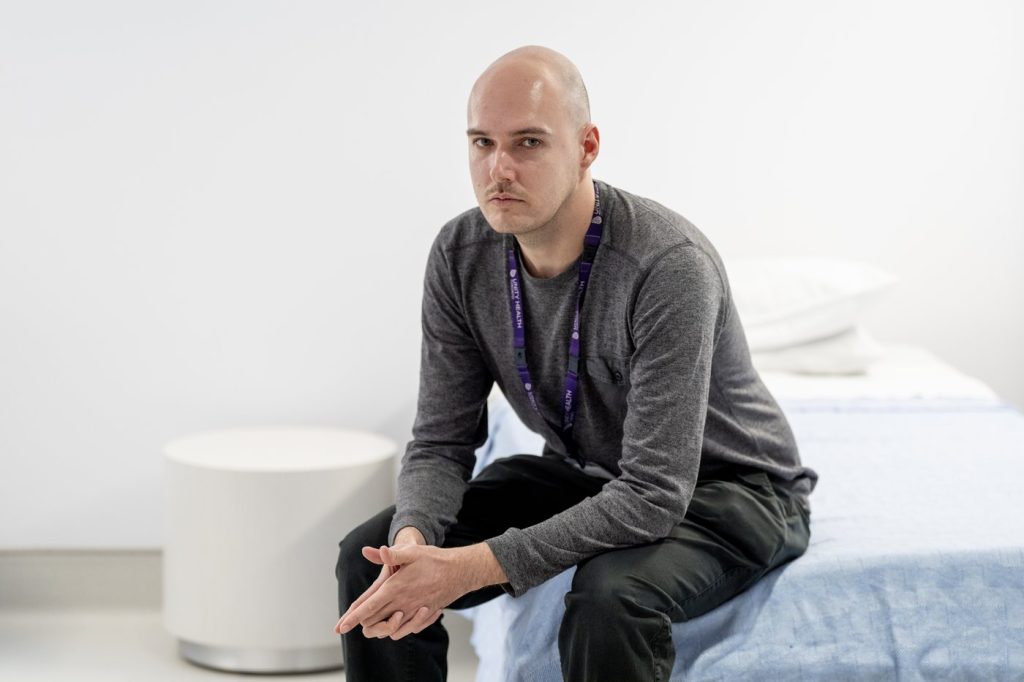‘It’s an optimistic space:’ Inside Toronto’s new drug withdrawal centre

Posted Nov 24, 2024 07:00:08 AM.
Last Updated Nov 24, 2024 07:01:16 AM.
TORONTO — Joshua Orson sits on the edge of a bed in a bright, clean room, thinking about his journey from addict to health-care worker.
The room is part of a new, 36-bed detox space in downtown Toronto that largely helps homeless patients, although it’s open to anyone who needs to get clean. There are private and shared rooms, a kitchen with cooked meals, laundry rooms and several lounges to play cards or watch television.
The space offers group and individual therapy, with addictions counsellors and nurses on the clock 24 hours a day.
Withdrawal Management Services, operated by Unity Health Toronto, is free and funded by the Ministry of Health. It is one of four publicly funded residential detox facilities in Toronto that helps people get off drugs and alcohol.
It is a vastly different space from its previous iteration where Orson got clean – a dorm-style room inside a homeless shelter without private beds. It sat in an ancient building with an old heating system and poor ventilation.
“When you come to the door here, you’re given a sense of dignity and hope after losing so much of yourself to get there and I think that’s really important,” said Orson, who is now a peer support worker at the site.
“The space here suggests what you can become rather than where you’re at, which I felt the former space was more like where you’re at. It’s an optimistic space.”
The withdrawal centre had its official opening a few weeks ago, but it began operating in the summer. Its 36 beds were filled very quickly and it remains full, said Dr. Irfan Dhalla, a physician at St. Michael’s Hospital and the vice-president of clinical programs at Unity.
But spots open up frequently as the program is designed for short-term residential stays, he said, and day programs are also available.
Unity also operates two other withdrawal centres in the city with 51 beds. They are also full.
The demand is further proof of a severe shortage of detox beds across the province, Dhalla said.
Illicit fentanyl emerged in Ontario about a decade ago as the opioid crisis spread slowly eastward from British Columbia. Opioid overdose deaths spiked soon after.
Last year, nearly 2,600 Ontarians died from drug toxicity, the vast majority due to fentanyl alone, or fentanyl in combination with other drugs like benzodiazepines. That is a 50 per cent increase in deaths from 2019.
The prolonged crisis prompted the provincial government to fundamentally shift its approach to an abstinence-based model. It is set to close 10 supervised consumption sites, including five in Toronto, saying the spots are too close to daycares and schools.
The changes came after a Toronto woman was killed by a stray bullet in what police described as a shootout between drug dealers next to a supervised consumption site.
The province will instead launch 19 new “homelessness and addiction recovery treatment” – or HART — hubs, plus 375 highly supportive housing units at a planned cost of $378 million.
The overdose crisis has hit the homeless population particularly hard.
Through gangs and organized crime, opioids have found their way into virtually every nook and cranny in Ontario, from big cities such as Toronto and Ottawa to remote, fly-in First Nations in the north and everything in between.
The problem is pronounced in downtown Toronto, particularly in the area near the withdrawal centre, where a number of shelters and services for those without homes are also located.
The detox centre project took about a decade from concept to launch, Dhalla said. The space’s design is crucial to the success of the program, he said.
“There’s something about our physical spaces that convey care and love. It’s hard to feel cared for and loved when you are in a physical environment that is decrepit,” Dhalla said.
“But I would feel better if the people who needed the service had a home to go to after they left here.”
Patients can return for the day program to help maintain their recovery. The benefits of the new space aren’t just limited to patients, Dhalla said.
“To be honest, it’s very good for staff retention and staff well-being,” he said.
Getting off drugs wasn’t easy for Orson. He first tried them at 14 years old. He’d use a variety of substances, from heroin to benzodiazepines to alcohol.
“I was mostly an opioid user, that was the drug of choice,” he said.
He also lived with concurrent mental health struggles that included depression, anxiety and suicidal thoughts.
Throughout his 20s, he visited the hospital more often. One day in the emergency room, Orson was referred to a case manager who got him into a detox program.
“I realized this is kind of what help looks like and if I go out again, I’m gonna end up back here,” he said.
“So I might as well do it now. I was more at the end of my rope rather than being ready to get off drugs.”
He spent seven days at the old detox centre. It was dingy and rife with temptation inside and outside the shelter.
“You have to deal with yourself after a long time from being away from yourself because the substances would provide a kind of blanketing,” Orson said.
“It’s just a very hard experience.”
That same case worker also suggested Orson become a peer support worker. Immediately after detox, he sought training and found volunteer work. It wasn’t long before he found work at a shelter.
“I don’t think I would have maintained that (abstinence) without becoming a peer support worker because when you’re helping other people, you help yourself and it gives you purpose and it gives you a place to be,” Orson said.
“What people really need is hope and this whole space is very hopeful and it’s able to penetrate into that dark place that people are in.”
This report by The Canadian Press was first published Nov. 24, 2024.
Liam Casey, The Canadian Press








